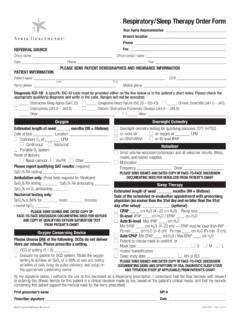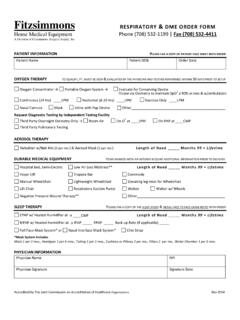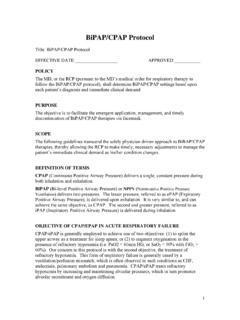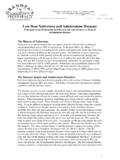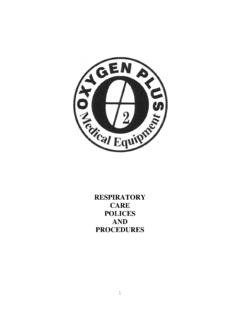Transcription of Dlopndemave nt e Implementation of Respiratory Care Plans
1 Wheatley/ShutterStock, Inc. Development and Implementation of Respiratory care Plans David C. Shelledy and Jay I. Peters CHAPTER OBJECTIVES 1. Describe the purpose of a Respiratory care plan . 2. Identify the key elements of a Respiratory care plan . 3. Describe common conditions that may require development of a Respiratory care plan . 4. Define Respiratory failure , and give examples of several types of Respiratory failure. 5. Define ventilatory failure , and contrast acute ventilatory failure and chronic ventilatory failure. 6. Give examples of appropriate outcome measures for a Respiratory care plan . 7. Outline the key steps in the development and Implementation of a Respiratory care plan . 8. Develop a Respiratory care plan to maintain adequate tissue oxygenation. 9. Create a Respiratory care plan for the treatment and/or prevention of bronchospasm and mucosal edema. 10. Describe the care of patients with asthma and COPD.
2 11. Design a Respiratory care plan to mobilize secretions. 12. Propose a Respiratory care plan for the treatment and/or prevention of atelectasis and pneumonia. 13. Give examples of types of Respiratory care Plans used in the intensive care unit. 14. Explain the role of diagnostic testing in the development of a Respiratory care plan . KEY TERMS acute lung injury (ALI) acute Respiratory distress syndrome (ARDS) acute Respiratory failure acute ventilatory failure (AVF) anti-inflammatory agents antiasthmatic medications asthma atelectasis bronchial hygiene bronchiectasis bronchodilator therapy bronchospasm chest physiotherapy (CPT) chronic bronchitis chronic ventilatory failure (CVF) chronic obstructive pulmonary disease (COPD) history hypoxemia incentive spirometry (IS) intermittent positive pressure breathing (IPPB) lung expansion therapy mechanical ventilation mucosal edema oxygen therapy physical pneumonia positive airway pressure (PAP)
3 Protocol pulmonary edema Respiratory care plan retained secretions SOAP notes treatment menu CHAPTER OUTLINE Introduction to Respiratory care Plans Common Conditions Requiring care plan Development Respiratory care plan Development Maintain Tissue Oxygenation Treat and/or Prevent Bronchospasm and Mucosal Edema Mobilize and Remove Secretions Provide Lung Expansion therapy Critical care and Mechanical Ventilation Diagnostic Testing Respiratory care plan Format Overview This chapter provides a guide to the development, Implementation , and evaluation of Respiratory care Plans . In order to develop an appropriate Respiratory care plan , the clinician must first perform a thorough patient assessment, including a review of the patient s existing medical record, a patient interview, and a physical assessment. The bedside measurement of clini-cal parameters related to oxygenation, ventilation, and pulmonary function may be performed.
4 Pulse oximetry (Sp 2 ) is often used to assess oxygenation status. Arte-rial blood gases should be obtained if there is concern 23 CHAPTER2 2320/09/14 11:37 am Table 2-1 Types of care Provided in the Respiratory care plan Basic Respiratory care Oxygen therapy Secretion management Sputum induction Management of bronchospasm and mucosal edema Lung expansion therapy Critical Respiratory care Invasive mechanical ventilatory support Noninvasive mechanical ventilatory support Physiologic monitoring Cardiac and hemodynamic monitoring Suctioning and airway care Airway intubation Advanced cardiovascular life support Metabolic studies Extracorporeal membrane oxygenation Mechanical circulatory assistance Basic care in the intensive care setting Diagnostic Testing Oximetry Arterial blood gases Pulmonary function testing Cardiac testing ( , ECG, invasive cardiology, cardiac catheterization laboratory)
5 Ultrasound (echocardiography, other) Sleep studies Exercise testing Special Procedures Transport Patient education Smoking cessation Disease management Pulmonary rehabilitation Cardiac rehabilitation regarding the patient s ventilatory status, acid base balance, or the reliability of Sp 2 values. Laboratory, imaging, and other diagnostic studies may be needed to further define and clarify the patient s problem and diagnosis. Following establishment and clarification of the patient s diagnosis and/or problem list (see Chapter 1), a Respiratory care plan is developed, implemented, and evaluated. Introduction to Respiratory care Plans The Respiratory care plan provides a written descrip-tion of the care the patient is to receive. The plan is based on a careful patient interview and physical assessment, review of diagnostic test results, and con-sideration of the treatment modalities available, some-times known as the treatment menu.
6 The Respiratory care plan may take the form of physician s orders, a detailed progress note in the medical record, an estab-lished protocol , completion of a standardized respira-tory care consultation and treatment plan , or the use of problem-oriented medical records ( , SOAP notes). The Respiratory care plan can be viewed as an individu-alized protocol for the patient. A basic Respiratory care plan often includes the fol-lowing elements: Goals of therapy Device or procedure to be used or medications to be given Method or appliance to be used Gas source or oxygen concentration Device pressure, volume, and/or flow Frequency of administration and duration of therapy SOAP notes are sometimes used to document patient care Plans : S (Subjective): Refers to what the patient says or subjective information obtained from chart. O (Objective): Refers to what the clinician observes or objective test results.
7 A (Assessment): Refers to the clinician s assessment. P ( plan ): Refers to the plan of care . The Respiratory care plan may also include a state-ment of how the intensity and/or duration of therapy will be adjusted and when the therapy will be discon-tinued. Assessment of the outcomes of therapy may also be included, as well as measurable objectives of the care delivered. In summary, the Respiratory care plan provides the written plan of treatment that the patient will receive. The plan may include goals, rationale, significance, and a description of how care will be assessed. Following a careful patient assessment, the Respiratory care plan is developed, implemented, and evaluated. A summary of the types of care often included in the Respiratory care plan is provided in Table 2-1 . Common Conditions Requiring Respiratory care plan Development Problems that affect oxygenation and/or ventilation often require the development of a Respiratory care plan .
8 Other common Respiratory problems include bron-chospasm and mucosal edema , retained secretions , airway plugging, infection, consolidation, inadequate lung expansion, atelectasis , and pulmonary edema . Common disease states or conditions encountered in the physician s office, clinic, or acute care setting that may require Respiratory care include upper Respiratory tract infection, pneumonia , acute bronchitis, asthma , chronic obstructive pulmonary disease (COPD; includ-ing emphysema and chronic bronchitis ), pulmonary 24 CHAPTER 2 Development and Implementation of Respiratory care 2420/09/14 11:37 amhypertension, congestive heart failure (CHF), lung can-cer, pulmonary fibrosis, pulmonary emboli, postopera-tive pulmonary complications, and acute Respiratory failure (see Chapter 1). Respiratory Failure Respiration refers to the exchange of oxygen (O 2 ) and carbon dioxide (CO 2 ) across the lung and pulmonary capillaries (external respiration) and at the tissue level (internal respiration).
9 Respiratory failure, broadly defined, is an inability of the heart and lungs to provide adequate tissue oxygenation and/or carbon dioxide removal. 1,2 Acute Respiratory failure may be defined as a sudden decrease in arterial blood oxygen levels with or without carbon dioxide retention. 1,2 Acute lung injury (ALI) and acute Respiratory distress syndrome (ARDS) are two special cases of Respiratory failure that are characterized by oxygenation problems that gener-ally do not respond well to basic oxygen therapy . The term hypoxemic Respiratory failure (aka lung failure ) is sometimes used when the primary problem is oxy-genation. 3 Chapter 6 describes the assessment of a patient s oxygenation status. Box 2-1 summarizes the various types of Respiratory failure. The most common reason for initiation of mechani-cal ventilatory support is hypercapnic Respiratory fail-ure (aka ventilatory failure or pump failure ).
10 3,4 Acute ventilatory failure (AVF) can be defined as a sudden rise in arterial CO 2 levels (as assessed by Pa 2 ) with a cor-responding decrease in pH. 5 Respiratory muscle fatigue and an increased work of breathing may lead to acute ventilatory failure. Decreased ventilatory drive due to narcotic or sedative drug overdose, head trauma, or stroke can also result in AVF. Common disease states or conditions associated with the development of AVF include severe pneumonia, ALI, ARDS, massive or submassive pulmonary emboli, CHF, and pulmonary edema. Shock, trauma, smoke or chemical inhalation, aspiration, and near drowning may also cause AVF. Acute exacerbation of COPD, acute severe asthma, severe burns, upper airway obstruction, obesity, and thoracic deformity all predispose patients to the development of AVF. Neuromuscular disease such as Guillain-Barr syndrome, myasthenia gravis, and spinal cord injury may also precipitate AVF.










